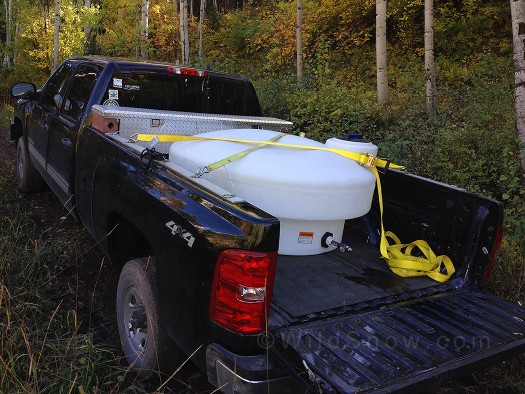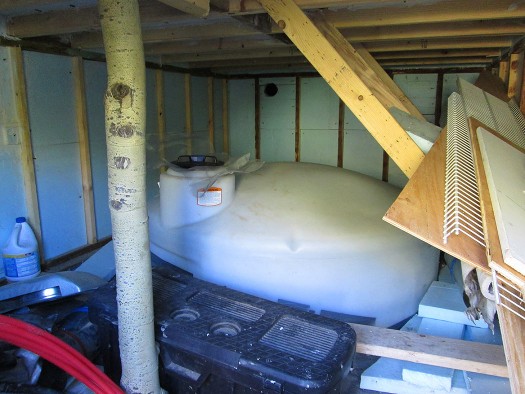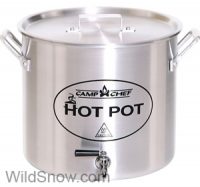This post was first published a few years ago, when we installed the water tank at our backcountry diggs. Figured I’d bring it to the top with updates regarding our camping water system.
Everything we’re doing up here in the high Colorado mountains is temporary, both due to costs but also the land use code requiring most structures or shelters to be portable (preferably on wheels or skids) unless they go through the full permitting process. Those kinds of larger projects are unnecessary for us at this point. While we do probably want to build something “real” in the future, that’s way way in the future. Meanwhile, the idea is to enjoy the place and not get into a big expensive project.
So, the water upgrades. Our property is mostly on steep grade. Inconvenient for building stuff but makes for easy location of gravity feed water. Burying a freeze-proof water line down to the camping shelter tiny house was way too big and pricey a project, and not temporary enough. So we first built a small insulated closet-like structure about 30 linear feet downhill from the tank. I buried and insulated a PEX pipe, terminated at a freeze proof hose bib inside the closet. During winter, we fill a water jug here and man haul it the hundred feet or so down to the cabin.
For summer, I ran a PEX line on the surface (hidden by rocks for cosmetics) down to the cabin. Another hose bib on the porch gives us convenient water. Vertical drop is about 15 feet, which while not providing standard residential pressure, gives about 6 PSI and squirts plenty strong for filling the teakettle and dish bucket. This part of the system is drained and valved off during winter. For fun, I also experimented with bringing a water line to the sink, but with only a bucket as a drain system that can result in a flood disaster if you don’t notice even a small drip. So I’d call that a temporary test for sure.
Those of you just beginning this sort of project might be curious as to what it took to insulate a freeze-proof shallow buried water line (the one between tank and closet). I only buried that 3/4 inch PEX about 18 inches, while code probably calls for something like 4 feet at this elevation. The trick is digging a fairly wide ditch, about two feet, then laying several layers of blue foam over the line, then covering. Expensive, tedious and non-code, so only good for this temporary type stuff at short distance. But it works for us.
2013 post below:
The camping scene at our “tiny house” has worked well over the past few years. Small at about 16×9 feet, but comfy with a wood stove and 12 volt solar lighting. We put in a gravity feed water system using a 5-gallon jug in the loft, but got tired of hauling water from town for every visit. Instead, why not haul H2O just a couple times a year and fill a big tank on our property, which could then be used like a spring, or even hooked up with a hose during non-freeze months? With a big enough tank we would have more water than we’d ever need just a few steps away.

Annual refill for the water tank. Silverado Duramax truckosaurus is the correct tool for the job. The 200 gallon tank in the truck is used to fill a 400 gallon tank in an insulated enclosure.
We engineered a solution by acquiring a couple of above-grade pickup truck water tanks. (Cheap used tanks are available, but for drinking water you have to buy new ones since you have no way of knowing what’s been in a used tank.) We enclosed the 400 gallon tank in an insulated stick-framed box. The tank is set a few feet into the ground to discourage freezing and allow the cover box to be shorter in height. Since the tank enclosure box needed a roof, we built a tool shed on top. While engineered for extreme snow loads and depth, everything was done small and portable so as not to create problems with building codes.
For a water tap, we buried about 10 feet of flexible hose a few feet below grade and daylighted that down the hillside from the tank via a freeze proof hose-bib faucet like you’d use on the outside of a house. During winter, a tarp and a few logs create a snow cave where we access the faucet and fill water containers. (See update at beginning of post for our latest hose configurations.)
Filling the tank is done once or twice a year using another 200 gallon truck tank, as shown in photo above. If I ever wondered why we own a truckosaurus, those ponderings have been put to rest. Water is heavy and our two-track vehicle access is steep.
Once a year we “flash” treat the permanent tank using bleach. More, for biological safety we filter or boil any water we drink out of the permanent tank — though the H20 remains clear, cold and clean since we source heavily chlorinated residential water drawn from our house in town.
One lesson learned: the caps on these tanks have an air vent that small insects such as ants can climb through. Install screen mesh over or under the cap to prevent interesting little floaters from appearing in your water supply. To clean debris out of the source tank, mount a fine screen dipper on a stick like the tool you use to clean stuff out of swimming pools.
Once winter weather begins we lay a few slabs of rigid “blue foam” insulation over the ground where we shallow buried the hose tap. It froze for a few days last winter during an extreme cold snap (20 below zero F), but otherwise stayed usable due to ground warmth keeping the freeze at bay. The water in the tank never freezes due to it being on the ground in an insulated box. We cover the hose bib with a small foam cover sold for that purpose, and blanket the whole assembly with an old synthetic sleeping bag when not in use.
Ventilating the insulated tank “house” is a challenge. Too much air flow and the water tank will freeze. Too little venting and humidity builds up to the point of damaging the covering structure and encouraging mold. Last winter we had a bit too much humidity. Improved solution is a vent in the door and a riser on the opposite end of the cover box made from 4-inch black plumbing pipe that warms in the sun, thus encouraging air flow. I’ll monitor temperatures this winter and restrict air flow if it looks like we’re risking a freeze.

Water storage tank in insulated enclosure. I used 2x6 floor joists above to reduce height of final structure, instead of 2x8s or 2x10x. They're a bit over-spanned, hence the bracing. Plenty of storage for stuff that's not moisture sensitive. This is really just a 'cap' over the tank, sitting on landscape timbers so as not to have a foundation and get counted as a permanent structure. A tool shed sits on top, again, very temporary, all assembled with screws and could be moved around by dragging on skids.
WildSnow.com publisher emeritus and founder Lou (Louis Dawson) has a 50+ years career in climbing, backcountry skiing and ski mountaineering. He was the first person in history to ski down all 54 Colorado 14,000-foot peaks, has authored numerous books about about backcountry skiing, and has skied from the summit of Denali in Alaska, North America’s highest mountain.

